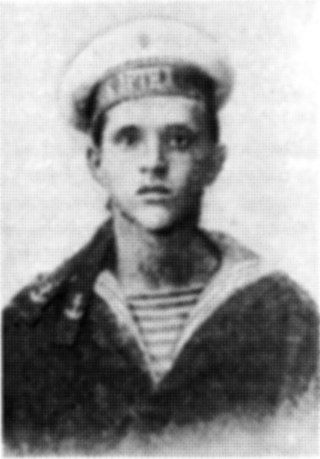
Peter Andreyevich Arshinov, was a Russian anarchist revolutionary and intellectual who chronicled the history of the Makhnovshchina.

Nestor Ivanovych Makhno, also known as Batko Makhno, was a Ukrainian anarchist revolutionary and the commander of the Revolutionary Insurgent Army of Ukraine during the Ukrainian War of Independence. He established the Makhnovshchina, a mass movement by the Ukrainian peasantry to establish anarchist communism in the country between 1918 and 1921. Initially centered around Makhno's home province of Katerynoslav and hometown of Huliaipole, it came to exert a strong influence over large areas of southern Ukraine, specifically in what is now the Zaporizhzhia Oblast of Ukraine.

Dmitry Ivanovich Popov was a Russian sailor and Left Socialist-Revolutionary that led the Left SR uprising against the Bolsheviks in July 1918. Following the suppression of the uprising, he joined the Revolutionary Insurgent Army of Ukraine and became a leading member, spearheading the negotiations between the Makhnovists and the Bolsheviks until his arrest and execution by the Cheka.
The Makhnovshchina was a mass movement to establish anarchist communism in southern and eastern Ukraine during the Ukrainian War of Independence of 1917–1921. Named after Nestor Makhno, the commander-in-chief of the Revolutionary Insurgent Army of Ukraine, its aim was to create a system of free soviets that would manage the transition towards a stateless and classless society.

Viktor Fedorovych Bilash was the Chief of Staff of the Revolutionary Insurgent Army of Ukraine (RIAU) under Nestor Makhno. A gifted military commander, Bilash himself planned many of the Insurgent Army's operations, later becoming its commander in chief after Makhno's flight into exile.

Semen Mykytovych Karetnyk was a Ukrainian anarchist and a commander of the Revolutionary Insurgent Army of Ukraine (RIAU). He often replaced Nestor Makhno as supreme commander of the Insurgent Army in 1920. Karetnyk gained a reputation for his central role in defeating the White Army in Crimea in November 1920.
The Nabat Confederation of Anarchist Organizations, better known simply as the Nabat, was a Ukrainian anarchist organization that came to prominence during the Ukrainian War of Independence. The organization, based in Kharkiv, had branches in all of Ukraine's major cities. Its constitution was designed to be appealing to each of the different anarchist schools of thought.

The Revolutionary Insurgent Army of Ukraine, also known as Makhnovtsi, named after their leader Nestor Makhno, was an anarchist army formed largely of Ukrainian peasants and workers during the Russian Civil War of 1917–1922. They protected the operation of "free soviets" and libertarian communes by the Makhnovshchina, an attempt to form a stateless anarcho-communist society from 1918 to 1921 during the Ukrainian War of Independence.

Agafya "Halyna" Andriivna Kuzmenko was a Ukrainian teacher and anarchist revolutionary. After moving to southern Ukraine, she became a prominent figure within the ranks of the Makhnovshchina, a mass movement to establish a libertarian communist society. Kuzmenko spearheaded the movement's educational activities, promoted Ukrainization and acted as an outspoken advocate of women's rights. Along with her husband, the anarchist military leader Nestor Makhno, in 1921 she fled into exile from the political repression in Ukraine. While imprisoned for subversive activities in Poland, she gave birth to her daughter Elena Mikhnenko, whom she brought with her to Paris. Following the death of her husband, the outbreak of World War II saw her deportation for forced labour, first by the Nazis and then by the Soviets. After her release, she spent her final days with her daughter in Kazakh SSR.
Mikhail Uralov was a Russian anarchist, the head of the "Black Guard" combat units of the Moscow Federation of Anarchists ,and a commander of the Revolutionary Insurgent Army of Ukraine.

The Union of Poor Peasants, also known as the Peasant Group of Anarcho-Communists or the Huliaipole Anarchist Group, was an underground anarchist organization, operating in the years 1905–1908 in the Huliaipole Raion in Ukraine.

The Military Revolutionary Council was the de facto executive of the Makhnovshchina, empowered to act during the interim between sittings of the Regional Congresses.

The Regional Congresses of Peasants, Workers and Insurgents represented the "highest form of democratic authority" within the political system of the Makhnovshchina. They brought together delegates from the region's peasantry, industrial workers and insurgent soldiers, which would discuss the issues at hand and take their decisions back with them to local popular assemblies.
The Draft Declaration was a theoretical document, drafted by the Revolutionary Insurgent Army of Ukraine, which outlined the Makhnovshchina's program of free soviets as a foundation for its transition towards a stateless society of libertarian communism.

The flags of the Makhnovshchina consisted of a number of different black and red flags, each emblazoned with anarchist and socialist slogans.
The Polonsky conspiracy, also known as the Polonsky plot or Polonsky affair, was an attempt by Ukrainian Bolsheviks to overthrow the Makhnovshchina during the autumn of 1919.
Yosif Isaakovich Gotman, also known by his nom de plureYosif the Emigrant, was a Ukrainian anarchist and a leading member of the Nabat and the Makhnovshchina.
The Road to Freedom was the main newspaper of the Makhnovist movement, publishing 50 issues from May 1919 to November 1920.

The Starobilsk agreement was a 1920 political and military alliance between the Makhnovshchina, an anarchist mass movement led by Nestor Makhno's Insurgent Army, and the Ukrainian Soviet Socialist Republic, which the Bolsheviks had established as the legitimate government of Ukraine.
The Bolshevik–Makhnovist conflict was a period of political and military conflict between the Ukrainian Soviet Socialist Republic and the Makhnovshchina, for control over southern Ukraine. The Bolsheviks aimed to eliminate the Makhnovshchina and neutralise its peasant base. In turn, the Makhnovists fought against the implementation of the Red Terror and the policy of war communism.












